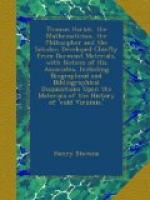When Raleigh found the cords thus tightening round him, he offered sundry concessions and services for life and liberty. He would carry out his schemes for enriching the king and the kingdom by conquering and exploring Guiana; he would accept exile in Holland; or emigrate to Virginia, and help to build up a new English empire in the West; but all in vain. It was feared that his unexpired and dormant patent might interfere with the King’s own Virginia charter. So Raleigh and Hariot worked on, but relieved the tedium by ever changing study. Every year or two, as long as he could command through himself or friends the resources, Raleigh sent privately a reconnoitring and intelligence ship to Guiana, to keep that pet enterprise alive. In this delicate matter Hariot was Sir Walter’s geographer and assayer, while Hariot’s old college friend, Keymis, was his factor or shipping agent.
Then come Raleigh’s Essays and smaller writing with his hopeful correspondence with the Queen and Prince Henry. Lady Raleigh’s privileges, after six years, ceased in 1611; probably about the time that Cecil was for some unaccountable reason prospecting actively for new evidence against both Sir Walter and Percy. The years 1610 and 1611 were anxious times for them both; but they were bright days for Hariot, with his invention of the telescope and his discoveries. Whether in the Tower, administering new scientific delicacies and delights to the prisoners; or at Sion, unlocking the secrets of the starry firmament by night, in his observatory; or floating between Sion and the Tower by day on the broad bosom of the Thames, prying into the optical secrets of lenses, and inventing his perspective trunks by which he could bring distant objects near, Hariot in foggy England of the north was working out almost the same brilliant series of discoveries that Galileo was making in Italy. To this day, with our undated and indefinite material, even with the new and much more precise evidence now for the first time herewith produced, it is difficult to decide which of them first invented the telescope, or first by actual observation with that marvellous instrument confirmed the truth of the Copernican System by revealing the spots on the Sun, the orbit of Mars, the horns of Venus, the satellites of Jupiter, the mountains in the Moon, the elliptical orbits of comets, etc. It is manifest, however, that they were both working in the same groove and at the same time.
Hariot was undoubtedly as great a mathematician and astronomer as Galileo. In 1607 at Ilfracombe and in South Wales, he had taken by hand and Jacob’s staff, the old patriarchal method, valuable observations of the comet of that year, and compared notes with his astronomical pupil William Lower, and afterwards with Kepler. This comet, now known as Halley’s, ought perhaps to have been named Hariot’s, for it confirmed his notions that the motions of the planets were not perfect circles and afforded probably the germ of his reasoning out the elliptical orbits of comets, especially afterhis friend and correspondent [see infra, pages 178-180] Kepler’s book de Motibus Stella Atartis came out in 1609, and he had invented and improved his telescope or perspective ’ truncke’ or cylinder in 1609-10.




